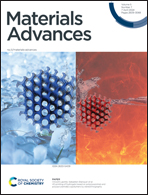Synthesis, characterization, and magnetic and antibacterial properties of a novel iron(iii) complex (CH3)2NH2[Fe(phen)Cl4]†
Abstract
A novel iron(III) complex (CH3)2NH2[Fe(phen)Cl4] (1) (phen = 1,10-phenanthroline) was synthesized, its structure was fully characterized using different techniques, and its in vitro antibacterial activity against various antibiotic-resistant Gram-positive and Gram-negative bacteria was evaluated. The structure of 1 is made up of mononuclear [Fe(phen)Cl4]− anions and dimethylammonium cations (CH3)2NH2+. Iron(III) is hexacoordinated to two nitrogen atoms of chelating phenanthroline and four chlorides forming a distorted octahedral environment around the metal atom. Complex 1 crystallizes in a triclinic system with the P![[1 with combining macron]](https://www.rsc.org/images/entities/char_0031_0304.gif) space group. 3D Hirshfeld surfaces and 2D fingerprint plots show that H⋯Cl interactions are the major contributors in maintaining the total surface. IR and UV-visible spectra indicated the coordination of 1,10-phenanthroline to iron (III) metal. Thermal stability experiments revealed that 1 is stable up to 428 K. Magnetic susceptibility measurements indicated a paramagnetic behavior at high temperatures. In vitro antibacterial activity was explored against two Gram-positive bacteria, Staphylococcus aureus CECT 86 and Listeria monocytogenes CECT 4031, and two Gram-negative bacteria, Escherichia coli CECT 99 and Klebsiella pneumoniae CECT 143T, using the disc diffusion method. Complex 1 clearly showed good activity against these bacteria and is a potential candidate for treating bacterial infections and promoting further development in their treatment.
space group. 3D Hirshfeld surfaces and 2D fingerprint plots show that H⋯Cl interactions are the major contributors in maintaining the total surface. IR and UV-visible spectra indicated the coordination of 1,10-phenanthroline to iron (III) metal. Thermal stability experiments revealed that 1 is stable up to 428 K. Magnetic susceptibility measurements indicated a paramagnetic behavior at high temperatures. In vitro antibacterial activity was explored against two Gram-positive bacteria, Staphylococcus aureus CECT 86 and Listeria monocytogenes CECT 4031, and two Gram-negative bacteria, Escherichia coli CECT 99 and Klebsiella pneumoniae CECT 143T, using the disc diffusion method. Complex 1 clearly showed good activity against these bacteria and is a potential candidate for treating bacterial infections and promoting further development in their treatment.
![Graphical abstract: Synthesis, characterization, and magnetic and antibacterial properties of a novel iron(iii) complex (CH3)2NH2[Fe(phen)Cl4]](/en/Image/Get?imageInfo.ImageType=GA&imageInfo.ImageIdentifier.ManuscriptID=D3MA00971H&imageInfo.ImageIdentifier.Year=2024)


 Please wait while we load your content...
Please wait while we load your content...